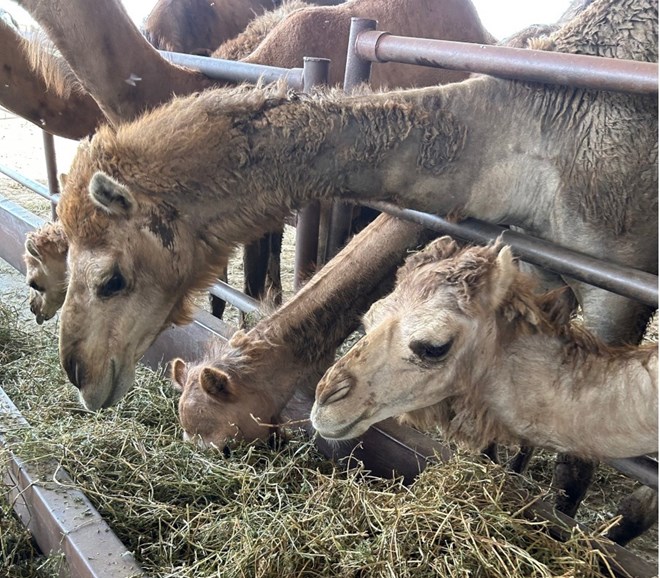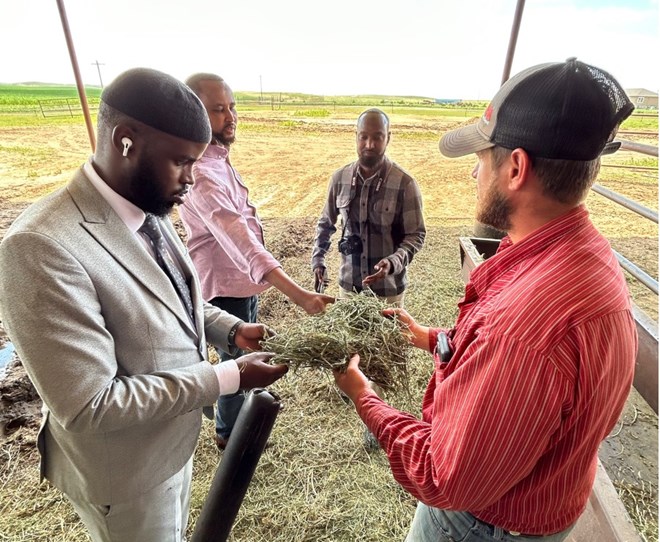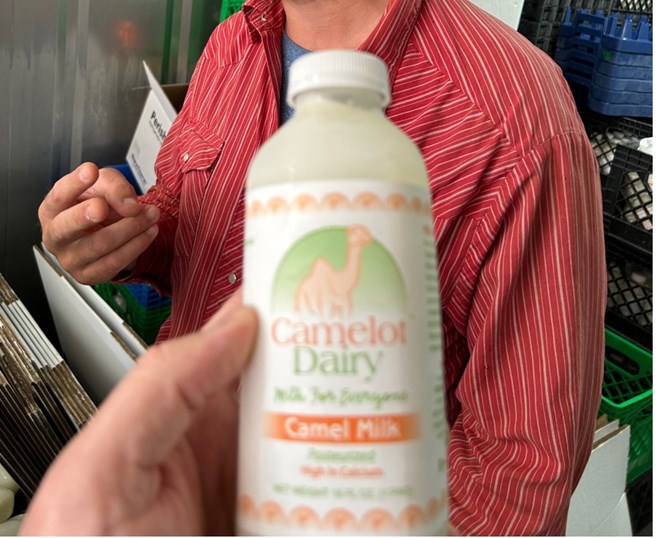Tuesday November 21, 2023

Camels at Camelot Dairy farm produce milk that is pasteurized, frozen and shipped to consumers. (University of Minnesota Extension)
ST. PAUL, Minn. — Can camels be raised as dairy in Minnesota? An innovative collaboration between University of Minnesota Extension and Somali community members in Stearns County is exploring the possibilities.
On the border of Nebraska in Wray, Colo., you can find camels roaming the pastures of the 35-acre Camelot Camel Dairy. This family-operated farm is one of two licensed camel dairies in the U.S. and has garnered attention for its rare and unique offering: camel milk.
The appeal of the Camelot Camel Dairy extends beyond its distinct dairy products for Somali community members in Stearns County, No. 1 dairy-producing county in Minnesota.
Partnering with a group of St. Cloud Somali community leaders through Extension's Regional Sustainable Development Partnership program, Extension educator Serdar Mamedov works with community stakeholders to raise awareness about access to halal foods or foods permissible under Islamic law, like camel’s milk.
In Minnesota, home to an estimated 76,000 people of Somali descent, Mamedov emphasizes the importance of halal foods.
"Halal foods are not just a want or need; it's a matter of food security. Demand for these products is rising in Minnesota, where we have a significant Muslim and Somali population,” says Mamedov.
Working to promote community health and wellness among the St. Cloud Somali population, Mamedov explores the community's needs with an open mind, and no question from the community is too far-fetched, even when community members asked, “Can we bring camels to Minnesota to raise as dairy?”
"I didn't view it as this impossible idea. I thought of it as an idea with potential worth exploring," says Mamedov.

Stearns County Somali community members visit Camelot Dairy to explore camel milk production. (University of Minnesota Extension)
An idea worth exploring
To explore the possibilities, Mamedov and a group of Somali community members ventured to Camelot Farms to learn how Hendrix successfully created a thriving environment for camels in North America.
Taking a group of visitors on a guided tour around the farm, Hendrix explained what seasonal adjustments are needed for camels’ wellbeing throughout the year, such as food, type of grass and shelter.
Interestingly, camels are relatively similar to dairy cows. “They forage and ruminate, so they basically eat the same thing as our cows, goats and deer from a nutritional standpoint,” says Extension dairy educator James Salfer. “But they do differ with milking management.”
One of the primary differences for camels — unlike dairy cows — is maintaining the cow-calf relationship during the milking process.
Walking through his milking routine, Hendrix offered fresh camel milk for the group to try. How did it taste? “Like my homeland and happy times,” says St. Cloud community member Ahmed Abdi.
Camels’ cultural connections
Much like goats, camels hold a profound significance among many Muslim populations. Known for its ability to adapt and survive in arid environments and extreme temperatures with little water and vegetation, the camel symbolizes resilience, strength and prosperity.
These towering creatures play a critical role in Somali culture and lifestyle with their multifunctional purposes for dairy, meat and wool production as well as transportation. Nutritionally, camel milk, with its slightly salty flavor and rich nutrients, is central to Somali customs and dietary traditions, especially among young children.
Although the benefits of camel products are wide-ranging, accessing goods like camel milk is challenging for Somali immigrant communities.
Kyle Hendrix, owner of Camelot Dairy, one of two licensed camel dairies in the US
"Camels don't produce as much milk as dairy cows,” says Salfer, making large camel herds in the U.S. a rarity and products like camel's milk a costly commodity — usually around $12 to $16 per pint compared to cow's milk at about 50 cents per pint.
"Camel milk offers a lot of benefits, but the key is a stable market. Farmers need assurance of demand, and consumers must be willing to pay the price of what it costs to raise and milk camels," says Salfer.
Dreams to reality
Having witnessed the potential of camel farming in the United States, the group is now taking their newfound knowledge back to Minnesota.
"We saw that it is possible to have camels in the United States, but now we need to consult with livestock experts to see if we can do this in Minnesota or if we should build relationships with producers like Hendrix to bring the product here,” says Mamedov.
“Either way, it needs to be affordable and accessible to the community.”
While still in the early stages, with the help of camel dairy farms like Camelot and the Stearns County Somali community, the dream of having access to milk from these traditional desert dwellers in states like Minnesota may no longer be a distant possibility.
